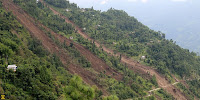Four people have been confirmed dead and seventeen other have been injured in a landslide in Gorkha District, Nepal, on Thursday 22 September 2016. The incident occured on the Manaslu Trekking Route, a popular tourist destination in Nepal, and one of the dead and eleven of the injured have been identified as Spanish nationas holidaying in the area, while one of the other fatalities has been identified as a local tour guide. Efforts are roportedly underway to evacuate the injured to a hospital in Kathmandu.
A victim of the 22 September 2016 Gorkha District landslide. AP.
The incident has been blamed on torrential rainfall that has fallen across the country in the last few days. Landslides
are common during the monsoon season in Nepal, which lasts from May to
September, with the highest rainfall occurring in July. Landslides
are a common problem after severe weather events, as excess pore water
pressure can overcome cohesion in soil and sediments, allowing them to
flow like liquids. Approximately 90% of all landslides are caused by
heavy rainfall. Landslides are a problem in Nepal every monsoon season, though this year has seen a particularly high instance of sich events, possibly due to the aftereffects of the April 2015 Nepal Earthquake, which disrupted rock formations across the country.
Monsoons
are tropical sea breezes triggered by heating of the land during the
warmer part of the year (summer). Both the land and sea are warmed by
the Sun, but the land has a lower ability to absorb heat, radiating it
back so that the air above landmasses becomes significantly warmer than
that over the sea, causing the air above the land to rise and drawing in
water from over the sea; since this has also been warmed it carries a
high evaporated water content, and brings with it heavy rainfall. In the
tropical dry season the situation is reversed, as the air over the land
cools more rapidly with the seasons, leading to warmer air over the
sea, and thus breezes moving from the shore to the sea (where air is
rising more rapidly) and a drying of the climate. This situation is
particularly intense in South Asia, due to the presence of the
Himalayas. High mountain ranges tend to force winds hitting them
upwards, which amplifies the South Asian Summer Monsoon, with higher
winds leading to more upward air movement, thus drawing in further air
from the sea.
Diagrammatic representation of wind and rainfall patterns in a tropical monsoon climate. Geosciences/University of Arizona.
See also...
 Landslides kill at least eleven people in Nepal. At series of landslides have killed at least eleven people in Nepal in
the first few days of...
Landslides kill at least eleven people in Nepal. At series of landslides have killed at least eleven people in Nepal in
the first few days of... Multiple deaths after landslide pushes bus into ravine in Rasuwa District, Nepal. Thirty-four people are known to have died, twenty five people are being
treated in hospitals and many more people are missing after a landslide
swept a bus into ravine in Rasuwa District, Nepal, on Tuesday...
Multiple deaths after landslide pushes bus into ravine in Rasuwa District, Nepal. Thirty-four people are known to have died, twenty five people are being
treated in hospitals and many more people are missing after a landslide
swept a bus into ravine in Rasuwa District, Nepal, on Tuesday...  Landslide hits bus in Palpa District, Nepal, killing at least three. Three
people have been confirmed dead after a landslide hit a bus traveling
from Palpa to Butwal on the Siddhartha Highway near Siddhababa...
Landslide hits bus in Palpa District, Nepal, killing at least three. Three
people have been confirmed dead after a landslide hit a bus traveling
from Palpa to Butwal on the Siddhartha Highway near Siddhababa...
Follow Sciency Thoughts on Facebook.


